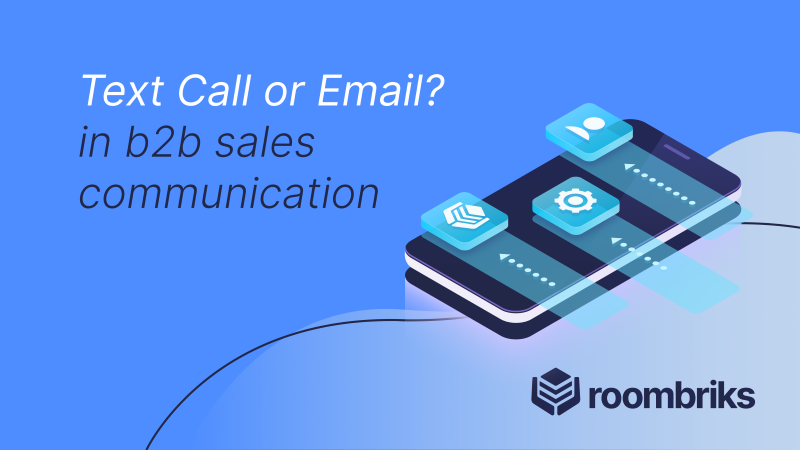To text call or email in b2b sales? communication preferences

roombriks team
Communicating in a modern hybrid workplace

Get Started With Your first Digital Sales Room
Summary
Effective communication with customers is important to the of success for any seller. With a plethora of communication channels available, from phone calls to emails and texts, choosing the right method can significantly impact customer satisfaction and ultimately drive sales.
The Customer Preference
It’s crucial to understand that customer preferences vary. Some customers may prefer the convenience of email, while others may appreciate the personal touch of a phone call. By taking the time to understand your customers’ preferences, you can tailor your communication strategy to meet their needs effectively.
Comparing Communication Channels in Sales: Phone Calls, Emails, and Text Messages
Phone Calls: Personalization and Immediate Assistance
Phone calls offer a level of personalization and immediacy that other communication channels may lack. They allow sellers to address customer concerns in real-time, provide immediate assistance, and build rapport through direct conversation. Phone calls are particularly effective for complex inquiries or situations that require a human touch, such as resolving customer complaints or providing product demonstrations.
Additionally, phone calls can convey tone and emotion more effectively than written communication, reducing the likelihood of misunderstandings. However, it’s essential to respect customers’ time and preferences – excessive or unsolicited calls can be perceived as intrusive and may result in a negative experience.
Email: Versatility and Documentation
Email remains a popular communication channel for sellers due to its versatility and ability to provide detailed information. Emails are ideal for delivering formal communications, such as order confirmations, shipping updates, or promotional offers. They also allow sellers to document interactions with customers, providing a written record that can be referenced later if needed.
Moreover, emails offer the advantage of asynchronous communication, allowing customers to respond at their convenience. This flexibility is particularly valuable for busy or international customers who may not be available for immediate phone calls.
Text Messages: Conciseness and Timeliness
Text messages, or SMS, are increasingly being utilized by sellers to communicate with customers, particularly for quick updates or reminders. Text messages are concise, direct, and have a high open rate, making them an effective channel for time-sensitive information, such as appointment reminders, delivery notifications, or limited-time promotions.
However, it’s essential to use text messages judiciously and obtain explicit consent from customers before sending marketing messages. Unsolicited text messages can be perceived as intrusive and may lead to customer dissatisfaction or even legal repercussions.
Method Matchmaking
When to Call:
Building trust and rapport: For new customers or high-value transactions, a phone call adds a human touch and fosters connection.
Complex issues: When troubleshooting or explaining intricate details, a phone call allows for back-and-forth clarification.
Urgent matters: If a customer has a time-sensitive issue or requires immediate action, a phone call ensures prompt attention.
When to Text:
Quick updates: Order confirmations, delivery notifications, and appointment reminders are perfect for text messages.
Short questions: Simple inquiries about product availability or order status can be efficiently handled via text.
Informal communication: For some demographics or established customers, texts offer a casual, convenient touch.
When to Email:
Detailed information: Sending brochures, product descriptions, or lengthy explanations is best done via email.
Formal inquiries: For complaints, feedback, or official documentation, email provides a written record for future reference.
Asynchronous communication: When reaching customers across different time zones or those who prefer slower-paced communication, email is ideal.
The Issue With Phone/Text/Email
Phone Calls:
Even though phone calls offer a level of personalization and immediacy unmatched by other communication methods, they can also arrive at an inconvenient time, be time-consuming, and lack proper documentation.
Texting:
Although texting is a more convenient method for short questions, informal communication, and quick updates, it can be very impersonal and lead to misinterpretations. Additionally, the limited content format hinders deeper engagement.
Emails:
Email, like texting, is also susceptible to misinterpretation. It carries the risk of being ignored or, worse yet, caught in spam filters. Additionally, emails have limitations in formatting and can pose security risks
Even though you could choose one of the methods above, there is still risk of miscommunication. According to a Preply study on workplace communication, nearly 90% of employees reported instances of miscommunication via email, compared to slightly less miscommunication rates of around 80% for direct messages and text messages. Phone calls had the lowest reported rate of miscommunication, at 71%. This is according to a Preply study on workplace communication
Closing Thoughts
While traditional email, phone calls, text messages, and document sharing have their merits, They do create a potential of alot of miscommunication. Digital Sales Rooms offer a more advanced and efficient solution for B2B sales. They enhance interactivity, security, and collaboration, ultimately improving the overall sales process and increasing the likelihood of successful deals.
